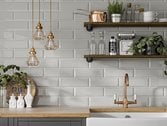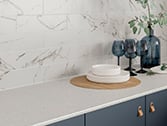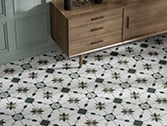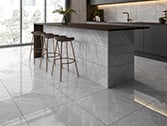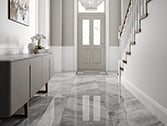Laminate Flooring
- Page 1: Laminate Flooring - Introduction
- Page 2: Laminate Flooring - Before you start
- Page 3: Laminate Flooring - Fitting twinclic
- Page 4: Laminate Flooring - Fitting 1clic2go
- Page 5: Laminate Flooring - Maintenance
- Page 6: Laminate Flooring - FAQs
- Back to Buying Guide
Laminate Flooring - FAQs
Q: What is laminate flooring?
Laminate Flooring is a High Density Fibreboard (HDF) based product designed to be a cheaper, easier to install alternative to traditional wood flooring. What appears to be a natural wood grain pattern is in fact a decorative paper overlaid with a hard wearing film. Both sheets are impregnated onto the top surface of a thin HDF making it a homogeneous product.
Laminate flooring is laid as a floating floor. This means it is not fixed directly to the subfloor. Instead the panels are fitted together without glue, using the profiles that have been machined into the edges of the laminate flooring boards.
Q: What is it made from?
80-85% Virgin Wood, usually softwoods such as Spruce and Pine. 15-20% Organic U/F & M/U/F Resins. 3 layers of impregnated paper, a decorative top layer, an overlay (for wear resistance) and a balance paper for the bottom surface of the laminate flooring.
Q: How is it made?
Laminate flooring core is made from virgin wood, refined to wood fibre. The resins are added to the fibre before it is dried to approx. 6.5% moisture content. The fibre is then laid onto a continuous mat and fed into the press where heat and pressure bond the resin to the fibre to create a HDF board.
This board is then cut into large sheets, cooled, before the top and bottom surface of the HDF is sanded off. The large HDF panel is then cut to smaller sizes in order for further processing.
The HDF is then fed onto the Melamine Facing press where the decorative paper, the hard wearing overlay and bottom balance paper are pressed onto the board, again using heat and pressure to impregnate the papers into the surface of the HDF board. For the final step of manufacture, the impregnated boards are sent to the laminate flooring line where the boards are cut into the exact size panels. The profiles are then machined into the edges of the board (to allow them to be fitted together without glue), and finally the panels are boxed up and stacked into large pallets ready for distribution.
Q: Where can I install my laminate flooring?
Our laminate flooring is an extremely versatile flooring product. It can be installed in virtually any room of your home as well as commercial environments such as high traffic areas and places where hygiene is paramount including:
- Bedroom
- Living Room
- Children’s Room
- Hall
- Kitchen
- Office (12mm products only)
There are some areas that we do not recommend installing laminate flooring such as bathrooms, wet rooms and saunas.
Q: What do I have to do with the packs before installation?
There are several things to consider before you begin to install a laminate floor. Careful preparation before beginning will make installation a quick and easy process:
- 1) Store unopened packs in the room to be laid for 48hrs to acclimatise
- 2) Prepare all tools and accessories for laying.
- 3) Any unevenness in the sub floor of more than 2mm over 1m must be evened out.
- 4) The floor must be installed floating, do not glue, nail or screw the floor down, and remember to leave expansion gaps around walls and fixed objects.
- 5) Do not lay on carpet, remove prior to fitting.
- 6) Laminate is not suitable for humid or wet areas.
- 7) If laying over a stone/mineral sub floor, lay a Damp Proof Membrane (DPM); and for enhanced noise reduction use a special absorption product or underlay.
- 8) Under floor heating can be used, at a maximum of 27°C.
- 9) Check for visual damage to the panels, as once laid no claims can be made.
Q: How should I store my laminate flooring?
Laminate flooring is hygroscopic, meaning that it is susceptible to reaction to moisture levels in the atmosphere. It is necessary to ensure that flooring is installed in a stable environment. We recommend the boards are stored and laid in a relative humidity of between 45% - 65% and a room temperature of between 18% and 20%.
Q: Tips & Tricks for Installation
When cutting around heating pipes, place the panel in line both in front and alongside to ascertain accurate marks. Include an additional 30mm on top of the pipe diameter for expansion.
- Use a hand saw for accurate cutting then cut the panel across the short edge through the centre of the hole.
- Fit the large piece as normal, and then insert the smaller piece gluing contact areas to hold in place. If space is at a premium, and you are unable to fold down, trim the profile flush using a wood chisel and glue in place.
- To fit the floor neatly around door frames and architraves, turn over a panel, offer up to the frame to use as a thickness guide. Using a hand saw flush with the underside of the panel, cut the frame/architrave, and, remove the cut piece.
- Slide the panel under the frame, not forgetting to leave room for expansion.
- When measuring the width for the final row, rotate the panel 180° so the tongue faces, not forgetting space for expansion gaps.
- Once the panel is cut lay as normal. The space left for expansion will also allow space to fold the panels down.
Q: How do I determine the direction in which to install my laminate floor?
To decide where to begin laying your floor, consider incoming light. It is best to install laminate flooring in the direction of the main light source.
Q: What is the best way to clean a laminate floor?
Use a soft brush or vacuum cleaner to remove any surface dust. Do not use abrasive cleaners, steel wool or scouring pads, as they will damage your floor. For regular cleaning use a cloth, ensuring it is well wrung, it is important not to apply excess moisture to the floor.
Q: What can I do to maintain the look of my floor?
The Krono Original collection is virtually maintenance free. All it needs to restore its lustre after most incidents is a wipe with a damp cloth. To keep your laminated floor in good condition, be sure to use the floor exclusively under the recommended conditions. Put down a mat or rug to eliminate the risk of marks (gravel, soil etc.) inside doorways and around sinks, etc, to protect from spillages. Move furniture carefully to avoid damaging the laminated surface. Felt pads are recommended under chairs and heavy furniture.
Q: What textures are available?
Laminate Flooring comes in an array of We have a variety of stylish surface textures available created for long-lasting comfort and good looks:
- Authentic Embossed
- Woodgrain
- Exotic Finish
- Antique Stone
- Wood Finish
- Smooth Finish
- Rustical Finish
Q: What are the health benefits of laminate flooring?
Unlike dense carpet; dust and dirt cannot get a grip on the smooth surface of the laminate floor. Krono Original floors are a healthy alternative, because they are produced from natural raw materials -without using wood preservatives. In addition, they are chloride and PVC free, so that no harmful evaporations arise.
Q: What are the advantages of laminate flooring?
The main advantage with Laminate Flooring is it is easy to install, is very durable and hardwearing and relatively inexpensive compared to real hardwood flooring. It is also a very versatile product which can be used in various areas and low maintenance, and a more natural & healthy alternative to carpets.
Q: Why choose laminate flooring over carpet?
- 1) Easy to install
- 2) Cheaper
- 3) Low maintenance
- 4) Can be installed fairly quickly and inexpensively
- 5) More hygienic
- 6) Scratch resistant and fade resistant
- 7) Stain Resistant
- 8) Durable
- 9) Dust and dirt repellent
- 10) Aquastop core-suitable for splash areas
Q: What expansion gap do I need to leave?
An expansion gap is a necessary part of any successful installation because it allows space for the expansion of the floor as it responds to external influences of temperature and humidity. 10mm minimum must be left around the full perimeter and any fixed objects, and threshold strips in all doorways.
Q: How do I repair small scratches?
You cannot repair small scratches, therefore it is very important to use felt pads on all furniture.
Q: How do I workout how much flooring I will require?
Multiply the width by the length in metres then add 10% for cutting waste. If the room has bay windows, archways etc. to be cut around, then increase to 20%. You then divide the result by the square area in the packs.
Q: Is it possible to replace a damaged plank after installation?
Yes the boards can be lifted and refitted.
Q: Can laminate flooring be installed over underfloor heating?
Sub floors with hot water systems have to be prepared prior to fitting the laminate (special instructions are available). With regards to electrical heating systems we advise contacting the manufacturer; some systems have been tested and approved. The maximum temperature the floor should be heated to is 27°C.







